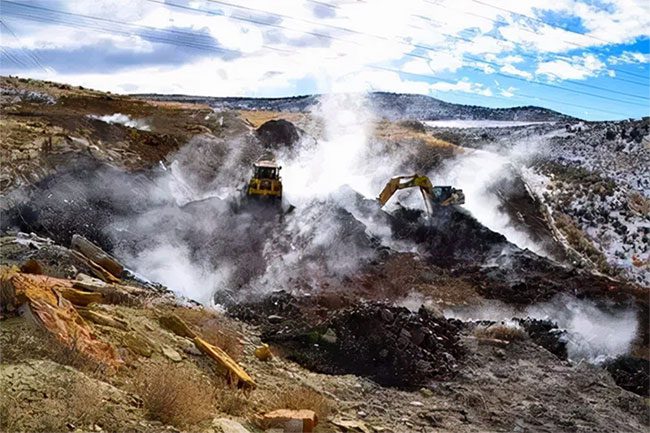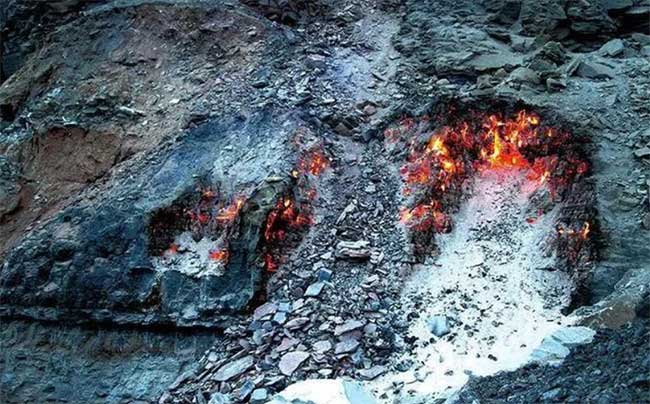This coal mine is likened to a real-life version of “Mount Doom,” and of course, the fire is not caused by a magical furnace.
Coal is the most abundant energy source on Earth, yet its relatively low cost is due to large reserves, earning it the label of cheap energy. As economies develop and the consumption of coal increases, people are beginning to realize its true value, as it takes a significant amount of time to regenerate.
China is a country rich in coal reserves. In particular, Mount Halan (located between Ningxia and Inner Mongolia, China) has unique geological conditions, making the coal quality here quite exceptional.
The coal in this region not only emits minimal ash and sulfur but also produces almost no smoke while releasing high thermal energy. It can be said that coal from Mount Halan is a very ideal chemical raw material. Therefore, it is dubbed “the king of coal.”
A smoldering volcano for 300 years on Mount Halan
The coal on Mount Halan is precious, but its seams have been wastefully burning. Some sources suggest that they have been self-igniting for 300 years, dating back to the Qing Dynasty. It is estimated that Mount Halan has burned more than 34,000 tons of coal each year from spontaneous combustion, resulting in a loss of 1 billion yuan annually.
Statistics indicate that the area of spontaneously combusting coal seams on Mount Halan reaches 16 hectares, and the fire continues to spread. Many people express regret over this issue, as not only are resources wasted, but this precious coal is also irretrievably lost.
The coal on Mount Halan has two characteristics: high gas content and high activity. This feature makes it akin to a “fuse.” When the upper coal seams catch fire naturally, the temperature can easily reach deeper coal mines. When temperatures rise to between 300-700°C, coal in nearby areas will also ignite.
Moreover, historical records indicate that small kilns or workshops for coal extraction have existed since ancient dynasties. By 1990, mining activities in the Mount Halan area had exploded, but by then, the technology had deteriorated.
The substandard mining practices have led to coal seams being exposed to the air, reacting with oxygen and spontaneously igniting. This area is riddled with numerous holes due to excessive and haphazard mining. This is also part of the reason for the persistent fire that has lasted for over 300 years.

Mining operations continue without pause. (Photo: Sohu)
Deadly consequences
The continuous burning of coal not only releases toxic gases such as carbon dioxide, carbon monoxide, and nitrogen oxides but also directly exterminates nearby wildlife. This further deteriorates local air quality and adversely affects human health.
Relevant statistics indicate that the area of spontaneous combustion at Mount Halan emits 12,900 tons of particulates and 5,324 tons of carbon dioxide annually. Such emissions are 269 times greater than that of a thermal power plant. Reports show that local residents have a higher incidence of respiratory diseases, digestive issues, and cancer compared to other regions.
Moreover, the excessive mining has created mountain cavities that can easily lead to landslides, rock fractures, and subsidence. Along with the degradation of the land, many species near the mining areas cannot survive, and a significant amount of vegetation has perished, exacerbating soil and water erosion during the rainy season.
Why can’t the fire be extinguished on Mount Halan?
According to statistics, from 2012 to 2015, nearly 20 large-scale gas explosions occurred in China at Mount Halan, with up to 9 incidents attributed to spontaneous combustion, causing significant human casualties. The smoldering fire here has caused severe damage year after year and has continued for over 300 years without being extinguished. The reason is not a lack of desire, but rather a “powerlessness.”
First and foremost, the coal at Mount Halan is highly flammable. Consequently, the fire can easily spread to adjacent coal seams. This situation has led to an increasing number of spontaneously igniting coal seams, making the probability of extinguishing them very low.

Coal continues to burn every day. (Photo: Sohu)
Furthermore, intensive coal mining has accelerated the exposure of coal seams. As the contact area between underground coal seams and oxygen increases, the risk of ignition also rises. Due to irrational mining practices, the interior of the mountain has been hollowed out. These cavities have provided oxygen to the deeper coal seams. Most of these fires are virtually inaccessible.
Additionally, the mountain has been mined from multiple directions, leading to numerous openings. Sealing these openings to prevent oxygen from entering is impossible.
Moreover, the method of extinguishing spontaneously burning coal is quite unique. We cannot extinguish it by spraying water like a regular fire because coal, when in contact with water, produces hydrogen, which can easily cause explosions. To date, no safe and reasonable method for extinguishing these fires has been found.
Coal is already a precious resource that is gradually depleting. To protect ourselves and future generations, we need to take more action to preserve these resources for the future.




















































